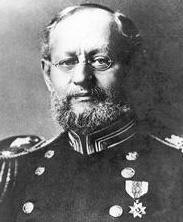Henry Martyn Robert: Difference between revisions
No edit summary |
m (Text replace - "[[Category:Culture and society" to "[[Category:Engineering and society") |
||
| Line 21: | Line 21: | ||
Robert was married twice, first in 1860 to Helen Marie Thresher, with whom he had five children. After his first wife died in 1895, he married Isabel Livingstone Hoagland in 1901. Robert died in Hornell, New York in 1923, and is buried at Arlington National Cemetery. | Robert was married twice, first in 1860 to Helen Marie Thresher, with whom he had five children. After his first wife died in 1895, he married Isabel Livingstone Hoagland in 1901. Robert died in Hornell, New York in 1923, and is buried at Arlington National Cemetery. | ||
[[Category:People and organizations|Robert]] [[Category: | [[Category:People and organizations|Robert]] [[Category:Engineering and society|Robert]] [[Category:Defense & security|Robert]] [[Category:Standardization|Robert]] | ||
Revision as of 16:44, 22 July 2014
Biography
Born: 2 May 1837
Died: 11 May 1923
U.S. General Henry Martyn Robert has been remembered as the man who standardized parliamentary procedure in the United States. But, before he penned his Rules, Robert began his career as an engineer.
Robert was born 2 May 1837 on his grandfather’s slave plantation in a small town near Robertville, S.C. He first exhibited his technical promise in Ohio, where his parents had relocated around his second birthday. Young Robert was precocious and opportunistic, and at age 15 received a coveted appointment to West Point to study military engineering. Upon his graduation in 1857, he was not only commissioned as an officer, but also invited to stay on as an assistant professor of natural philosophy, astronomy and practical military engineering. However, his engineering talents were soon needed elsewhere.
Assigned to the Army Corps of Engineers, in 1858 he led a detachment to the isthmus of Panama to explore the possibilities for a canal. In 1859, he built a fort on San Juan Island to protect the northwest United States from the British in British Columbia (the border with Canada had not yet been settled). In 1861, he helped to build the defenses of Washington, D.C., during the Civil War. From there he was posted to Philadelphia, and then to New Bedford, Mass. It was in New Bedford that he was first asked to preside over a church meeting; and it was here he first observed that, during the discussion of contentious subjects, meeting decorum tended to break down. When it came time to make decisions, each member referred, either implicitly or explicitly, to different rules of order, depending on their personal background and geographic origin. The result was a disorder that made prevented goals being accomplished and made the engineer uncomfortable.
In 1867, Robert was promoted to major and posted to San Francisco as the Corps’ chief engineer in the region. In that capacity, he oversaw the construction of harbor and river improvements in the Pacific Northwest. His position made him prominent in the community, and he became a board member of both the San Francisco YMCA and the First Baptist Church, among other organizations. Seeking order, he decided to try to congeal his thoughts about volunteer meetings on paper and put them into action. Robert began compiling a 16-page rules of order guide, which he intended for use with the various organizations to which he and his wife belonged. Due to a hectic schedule, Robert did not complete the manuscript that became the Rules of Order until the winter of 1874. Transferred to Wisconsin that year, the harsh weather prevented the Corps from carrying out several of its initiatives, giving Robert more time to work on his own project.
Robert’s background in military discipline may have, in part, led to his famous work. However, in the military methods for raising objections, for overruling the chair and so forth, are intentionally omitted from military protocol. If one looks closely at Robert’s Rules of Order — its structure, its analytical approach, its emphasis on practical solutions — one could argue more compellingly that his engineering training was the real origin of his rules. When it was completed he shopped it to publishers, but none were interested. While some saw the use for such a book, they assumed it could only come from a lawyer or legislator. Robert self-published and his book became a publishing and cultural phenomenon. By 1892, 140,000 copies had been printed.
Robert continued his engineering career with the Army, making improvements to harbors in Long Island, New York and Philadelphia, constructing locks and dams on the Tennessee and Cumberland Rivers, and improving the Southwest Pass of the Mississippi River. Shortly before his retirement in 1901, he was named Chief of Engineers in the Army and was also made brigadier general. After leaving the military, he continued his engineering work and designed a seawall for Galveston, Texas, after a devastating hurricane there in 1900.
Robert was married twice, first in 1860 to Helen Marie Thresher, with whom he had five children. After his first wife died in 1895, he married Isabel Livingstone Hoagland in 1901. Robert died in Hornell, New York in 1923, and is buried at Arlington National Cemetery.
